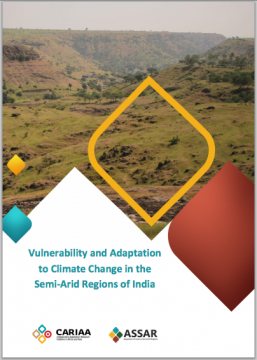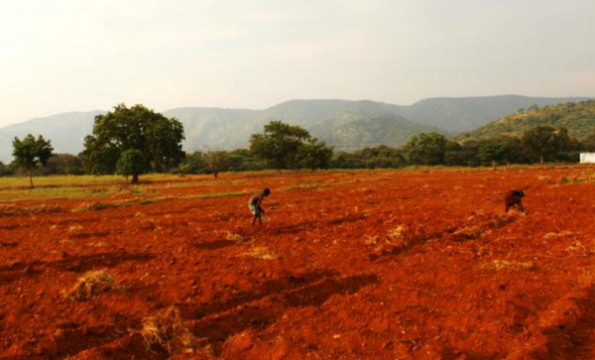Vulnerability and Adaptation to Climate Change in the Semi-Arid Regions of India: ASSAR Regional Diagnostic Study


Home to hundreds of millions of people, the semi-arid regions of Africa and Asia are particularly vulnerable to climate-related impacts and risks. Working in 11 countries in these regions, ASSAR is a research project that seeks to understand the factors that have prevented climate change adaptation from being more widespread and successful. This article features ASSAR’s work in India. To read about the project in other regions please see their respective articles.
Southern Africa West Africa East Africa
Introduction
India’s economic growth has been notably impressive in the last two decades but the country still faces numerous challenges, such as stagnant agricultural growth, rising regional and subregional inequality, unemployment, and inadequate access to public services for the poor. However, there has been a perceptible recent prioritisation aimed at reducing economic and social vulnerability of the poor and building their adaptive capacities.
Climate Change Trends and Projections
India experienced accelerated warming from 1971-2007, with the warming trend being particularly intense in the most recent decade (1998-2007). During this time a greater number of heat waves and hot days have also been recorded. Over the same time period the Indian Monsoon has weakened but intense rain events have become more frequent in some areas.
Recent climate simulations indicated temperature increases of more than 2˚C over central and northern parts of India for the period 2066-2095. However, changes in rain by the end of the 21st Century were not observed to be significant. At a sub-regional level, while ASSAR’s Bangalore and Moyar-Bhavani sub-regions experienced warming temperatures and rainfall declines, the Sangamner sub-region experienced less certain temperature trends and high variability in rainfall patterns (although rainfall has increased modestly since the 1990s).
Currently, available climate information is too coarse to be relevant to local decision-making processes. Statistical downscaling of climate projections to provide useful climate information for medium and long-term decision making, including the possibility of tailored climate information is the key research priority in the RRP phase. The impacts of, and feedbacks from, ecosystem and land use and land cover changes need to be additionally understood in the sub-regional context to efficiently understand the local climate.
Adaptation context
Recently, mainstreaming climate change adaptation into development efforts (by multiple actors) has gained prominence due to perceptible climate change impacts across regions and sectors. Recognising that the priorities for development and adaptation are closely related, India’s response is primarily shaped by the need to link the development of human, institutional and infrastructural capabilities in building adaptive capacities in people and systems.
Most current development-adaptation interventions in India and the sub-regions focus on water and agricultural sectors. Evidence from various adaptation projects suggests that risk management strategies at various scales and initiated by various actors, are enabling building of local adaptive capacities. However, such changes are not uniform across regions, sectors or scales. India’s rural systems have seen relatively higher and longer investment in direct climate change adaptation projects, as well as those that have adaptation co-benefits such as interventions for livelihood diversification, biodiversity conservation, sustainable agriculture and natural resource management. Given large development deficits and the vulnerabilities of the rural poor, coping strategies to manage risk are more common than adaptive action.
Governance and institutional barriers emerge as a key constraint to ongoing and future adaptation. Governance in much of India is fragmented, making coordination across different agencies and scales challenging. Cities in particular accumulate and generate new risks through unplanned development and deepening inequality. Urban settlements are vulnerable to food, energy and water fragility and consequent social and political unrest. Planning, including for risk management, often takes place at higher levels of government, while the role of local bodies, civil society and communities tends to be that of implementation with little room for innovation. The ways in which governance acts as a key barrier to adaptation are a) multiplicity and redundancy of actors and institutions, b) fragmentation of planning and execution, c) prevalence of top-down planning, d) institutional rigidity and path dependency and e) absence of certain actors and sectors in the planning process such as private sector participation and health.

Conclusion
To summarize the findings in the RDS report, India’s economic growth has been impressive, notably in the last two decades, but this has not translated into effective poverty reduction and balanced progress on other human development indicators. Environmental degradation, stagnant agricultural growth, rising regional and sub-regional inequality, poor quality and quantity of employment, and inadequate access to public services for the poor are some of the major national concerns. It is also noteworthy to highlight that the agriculture sector still remains the dominant livelihood source in India. Being primarily rain-fed, it is highly vulnerable to the changing climatic regime.
There is limited evidence on adaptation planning, particularly in the Indian context, that coherently addresses multiple challenges as well as recognises local, regional and national dynamics. These challenges range from identifying multiple stressors and their determinants to recognizing a huge flux in development transitions, especially in the rural-urban corridors. Further, there is insufficient understanding on how different actors address adaptation planning at different levels and negotiate interactions at each level. Examples of these interactions are interlinkages between national and regional priorities and sectoral linkages between agriculture, water and livelihoods.
There is also a need to understand the utility of creating tailored climate-messages that inform adaptive responses, while also maintaining a balance between immediate and long-term strategies. Medium to long-term climate information available for decision making, along with identification of appropriate institutional linkages, lacks evidence and is insufficiently tested in the Indian context. There is also a need to create an evidence-based understanding on how trade-offs between diverse adaptation practises are determined and appraised, in order to enable adaptation mainstreaming. These trade-offs refer to the burden of negative and positive impacts on participants, mostly economic in nature (mostly studied in the agriculture sector). Further, the trade-offs have to be simultaneously understood in the context of disturbing the existing socio-ecological system (in the case of Bangalore sub-region, for instance; large-scale development in primarily rural peri-urban areas have dis
(0) Comments
There is no content